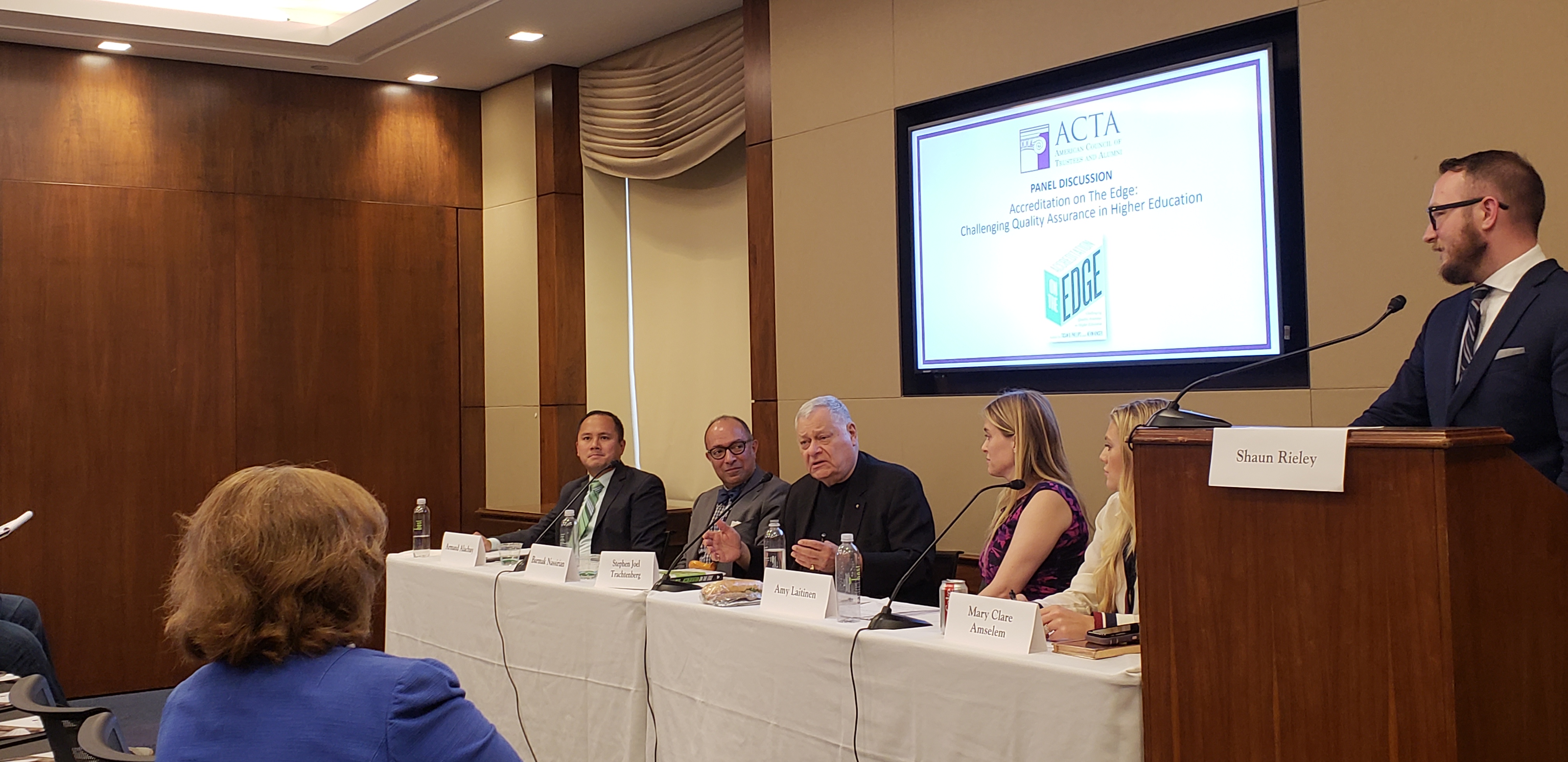Recently, ACTA hosted a panel discussion on Capitol Hill to discuss the future of higher education accreditation with a group of experts from a range of different perspectives. The event was loosely based on the new book from Johns Hopkins University Press, Accreditation on the Edge: Challenging Quality Assurance in Higher Education, to which ACTA contributed a chapter. Accreditation is a notoriously complex and arcane subject, especially when it comes to how it interacts with public policy. Because of this, accreditation is overlooked in discussions of education reform, save, perhaps, for the often contentious debate surrounding for-profit colleges and their accreditors.

From left to right: Armand Alacbay, Vice President for Trustee and Government Affairs, ACTA; Barmak Nassirian, Director of Federal Relations and Policy Analysis, American Association of State Colleges and Universities; Stephen Joel Trachtenberg, Ph.D., President Emeritus and University Professor of Public Service, George Washington University; Amy Laitinen, Director of Higher Education Policy, New America Foundation; Mary Clare Amselem, Policy Analyst for Education Policy Studies, The Heritage Foundation.
The release of Accreditation on the Edge, however, indicates that the tide may be turning: A fundamental rethinking of the accreditation regime is underway. While the movement toward accreditation reform remains inchoate, it is increasingly clear that a consensus is building. With that in mind, here are three major takeaways from the discussion:
The current accreditation regime is less than ideal.
As mentioned above, the panel included representatives from groups with widely differing perspectives and positions, yet all agreed that the current accreditation system is far from ideal.
The accreditation system is complex, and, in an important sense, a holdover from another time. The original function of accreditation was a voluntary peer-review process for improvement and quality assurance. It was not connected to access for federal funds until the 1950s with the introduction of the GI Bill, and later the Higher Education Act (HEA) in 1965, when its role as a gatekeeper was greatly expanded. It was selected as a gatekeeper of federal funds largely because the federal government lacked a sufficient mechanism for ensuring that tax dollars were being protected. However, the system was not designed to fulfill this function. Therefore, perversely, it often fails to do so, while simultaneously managing to impose on institutions a host of burdensome regulations and requirements that are of dubious value.
There is a growing consensus that a new system must be put in place that does more to ensure quality while also minimizing the regulatory burden on institutions so that they can direct their resources toward fulfilling their educational missions.
There is no single “silver bullet” fix.
Though virtually everyone agrees that the current system needs improvements, there is less consensus on what a more ideal system would look like. Furthermore, given the complexity of the system, it is not likely that any one fix will rectify all of the current challenges.
Like many social and governmental institutions, the current system is the result of numerous historical accidents which, though somewhat arbitrary, nevertheless restrict the range of possibilities for reform. The bottom line is that the system remains in place because, essentially, no one has come up with anything better: All of the comprehensive solutions that have been suggested over the years have substantial drawbacks.
Suggestions that the Department of Education play a more direct role are countered by concerns that the federal government is not equipped to make those kinds of judgment calls, and fear of worrisome governmental overreach. Suggestions that accreditors go back to a purely voluntary and advisory role are countered by concerns about the need to ensure that taxpayer dollars—as well as consumers—are protected from potential bad actors. Hence, there simply does not seem to be a satisfactory single solution to the problems with accreditation.
There are ways to make improvements.
Still, there are things that can be done to make improvements. All of the panelists made recommendations toward improving the system around the edges, even if a comprehensive, “silver bullet” fix does not seems to be forthcoming.
Topping ACTA’s list of recommendations is the need to ensure that accreditors are constrained in their ability to make arbitrary demands on colleges and universities, under threat of losing their eligibility to receive federal money. The HEA outlines 10 criteria which accreditors must adhere to when evaluating institutions under their purview; but it also includes a clause which appears to allow accreditors to go beyond these 10 standards, allowing accreditors to evaluate institutions, for the purpose of federal eligibility, on virtually any basis. ACTA recommends that, at the very least, it be clarified in the law that institutions may only lose their federal eligibility for an issue pertaining to one of the 10 criteria.
The future of higher education accreditation remains unclear, yet a consensus is emerging that the current system is unsustainable. Lawmakers, governors, policy professionals, and members of the higher education community must come together to develop solutions which will ensure high quality education at a reasonable price, while mitigating government and accreditor overreach to allow maximal institutional autonomy and diversity. American higher education is too important to the country—and the world—to settle for anything less.
